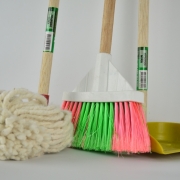Are You Polluting the Air Inside Your Home?
It’s not unusual to store things like paint, cleaning products, and craft supplies around the house. But did you know that these everyday items can be a source of indoor air pollution and have a negative impact on the quality of air inside your home? If you’re concerned about your home’s air quality, read on to learn more about household items that affect indoor air.
The DL on VOCs
Many household products are made with organic chemicals that naturally give off gasses called volatile organic compounds (VOCs) that are bad for indoor air quality. VOCs are emitted from thousands of items, such as dyes (in upholstery or carpet), paint on the walls, varnishes on wood floors or furniture, cleaners and more. So many household items give off VOCs that the EPA found that VOC levels are up to 10 times higher indoors than outdoors. Sometimes you can smell VOCs, but most of the time there is no smell, making it difficult to detect whether VOCs are present in your home. 
Breathing in low levels of VOCs for a long time may cause health problems, especially for people who have asthma or breathing problems. People exposed to low levels of VOCs for a long time may also experience headaches, dizziness or nausea.
Exposure to high levels of VOCs for a long time may lead to more serious conditions, like cancer, kidney damage or problems with your nervous system.
Because of the potential health problems associated with exposure to VOCs, it’s important to reduce the levels of VOCs in your home.
Reducing VOCs in Your Home
The best way to reduce VOCs in your home is to get rid of extra products and items that give off VOCs. If you recently completed a home remodeling project and have extra paint, flooring or other materials stacked somewhere, move them outside or into a shed where people don’t spend much time. If you keep extra cleaners and solvents in your home, keep only what you need indoors and move the rest to the garage or a shed.
Another option is to buy low-VOC products. Low-VOC options exist for paints and furnishings, making it possible to bring these items into your home but reduce your exposure to VOCs. Or, if you’re buying furniture, consider buying the floor model, which will have fewer VOCs to give off because it has been sitting out longer.
VOCs and Your Home’s Air
It is difficult to escape exposure to at least some VOCs. To keep the air in your home healthy, increase the amount of fresh air in your home by opening doors and windows when possible, and making sure your home’s ventilation system is running smoothly. An important part of maintaining your home’s ventilation system is ensuring it is free of dirt, dust and other things that can clog filters and impact the flow of air in the home. Schedule service to maintain your heating and air conditioning systems, and make sure air duct cleaning is part of your maintenance routine.
VOCs can be difficult to escape completely, but these tips can help you reduce your exposure and improve the quality of the air inside your home.
